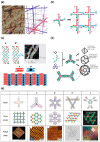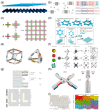Bottom-Up Self-Assembly Based on DNA Nanotechnology
- PMID: 33081252
- PMCID: PMC7603033
- DOI: 10.3390/nano10102047
Bottom-Up Self-Assembly Based on DNA Nanotechnology
Abstract
Manipulating materials at the atomic scale is one of the goals of the development of chemistry and materials science, as it provides the possibility to customize material properties; however, it still remains a huge challenge. Using DNA self-assembly, materials can be controlled at the nano scale to achieve atomic- or nano-scaled fabrication. The programmability and addressability of DNA molecules can be applied to realize the self-assembly of materials from the bottom-up, which is called DNA nanotechnology. DNA nanotechnology does not focus on the biological functions of DNA molecules, but combines them into motifs, and then assembles these motifs to form ordered two-dimensional (2D) or three-dimensional (3D) lattices. These lattices can serve as general templates to regulate the assembly of guest materials. In this review, we introduce three typical DNA self-assembly strategies in this field and highlight the significant progress of each. We also review the application of DNA self-assembly and propose perspectives in this field.
Keywords: DNA brick; DNA origami; DNA tile; bottom-up; nanoparticles; self-assembly.
Conflict of interest statement
The authors declare no conflict of interest.
Figures




Similar articles
-
DNA-Grafted 3D Superlattice Self-Assembly.Int J Mol Sci. 2021 Jul 15;22(14):7558. doi: 10.3390/ijms22147558. Int J Mol Sci. 2021. PMID: 34299179 Free PMC article. Review.
-
DNA origami: an outstanding platform for functions in nanophotonics and cancer therapy.Analyst. 2021 Mar 21;146(6):1807-1819. doi: 10.1039/d0an02160a. Epub 2021 Feb 17. Analyst. 2021. PMID: 33595553 Review.
-
Self-Assembly of Heterogeneously Shaped Nanoparticles into Plasmonic Metamolecules on DNA Origami.Chemistry. 2017 Oct 12;23(57):14177-14181. doi: 10.1002/chem.201703927. Epub 2017 Sep 13. Chemistry. 2017. PMID: 28833683
-
Layered-Crossover Tiles with Precisely Tunable Angles for 2D and 3D DNA Crystal Engineering.J Am Chem Soc. 2018 Nov 7;140(44):14670-14676. doi: 10.1021/jacs.8b07180. Epub 2018 Oct 29. J Am Chem Soc. 2018. PMID: 30336007
-
Directional Assembly of Nanoparticles by DNA Shapes: Towards Designed Architectures and Functionality.Top Curr Chem (Cham). 2020 Mar 27;378(2):36. doi: 10.1007/s41061-020-0301-0. Top Curr Chem (Cham). 2020. PMID: 32221698 Review.
Cited by
-
Interpenetrated and Bridged Nanocylinders from Self-Assembled Star Block Copolymers.Macromolecules. 2024 Jan 30;57(3):926-939. doi: 10.1021/acs.macromol.3c02088. eCollection 2024 Feb 13. Macromolecules. 2024. PMID: 38911231 Free PMC article.
-
The wending rhombus: Self-assembling 3D DNA crystals.Biophys J. 2022 Dec 20;121(24):4759-4765. doi: 10.1016/j.bpj.2022.08.019. Epub 2022 Aug 24. Biophys J. 2022. PMID: 36004779 Free PMC article. Review.
-
Recent Advances in Functional Nanomaterials for Diagnostic and Sensing Using Self-Assembled Monolayers.Int J Mol Sci. 2023 Jun 28;24(13):10819. doi: 10.3390/ijms241310819. Int J Mol Sci. 2023. PMID: 37445998 Free PMC article. Review.
-
Recent Advances in Functionalized Carbon Quantum Dots Integrated with Metal-Organic Frameworks: Emerging Platforms for Sensing and Food Safety Applications.Foods. 2025 Jun 11;14(12):2060. doi: 10.3390/foods14122060. Foods. 2025. PMID: 40565669 Free PMC article. Review.
-
Pairing nanoarchitectonics of oligodeoxyribonucleotides with complex diversity: concatemers and self-limited complexes.RSC Adv. 2022 Feb 23;12(11):6416-6431. doi: 10.1039/d2ra00155a. eCollection 2022 Feb 22. RSC Adv. 2022. PMID: 35424594 Free PMC article.
References
Publication types
Grants and funding
LinkOut - more resources
Full Text Sources

